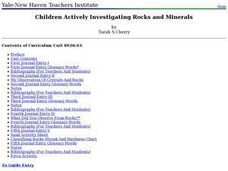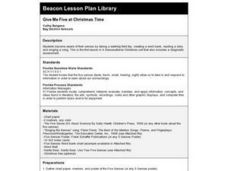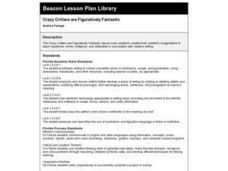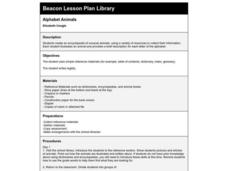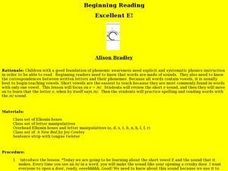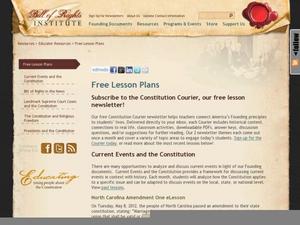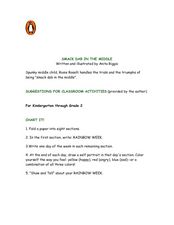Curated OER
New England Colonies
Students study the New England colonies. In this colonies lesson, students use a directed reading-thinking method to learn about the New England colonies. Students follow the method to make predictions, read the text, and analyze the...
Curated OER
Were Lewis and Clark respectful to the Native Americans they encountered on their journey?
Sixth graders debate whether or not Lewis and Clark were respectful of Native Americans they encountered on their journey. In this American History lesson plan, 6th graders review primary documents and diary entries from the Lewis...
Curated OER
Harry Potter Alive and Well In the Sorcerer's Stone
Learners brainstorm author's purpose, and use their imagination to draw pictures that illustrate what the purpose is. In this literature and writing lesson, student's use Harry Potter and the Sorcerer's Stone as a guide from which to work.
Curated OER
Children Actively Investigating Rocks and Minerals
Students follow directions to set up their own record keeping journal. As a class, they are introduced to the characteristics of crystals and identify three types of crystals they see in their everyday lives. They examine materials they...
Curated OER
International Curiosity and National Pride
Students look at their own culture and at Bulgarian culture to identify national, local, or ethnic traits. They identify at least three important characteristics of their culture that help make it unique and compose a list of questions...
Curated OER
Make a Snowflake
Students study the design of snowflakes. In this snow lesson, students discover the different shapes of a snowflake, and their similarities. Students study snowflakes outside, then create their own with popsicle sticks...
Curated OER
Emotions with Corduroy
First graders, after reading Corduroy, relate Corduroy's emotions to their own emotions in a 'feelings chart'. They relate feelings of friendship, acceptance and belonging.
Curated OER
Draw It!
Young scholars follow directions to make two- and three-dimensional shapes. Focusing on polygons, they use the shapes to solve real-world problems and review with the class. They read two of Shel Silverstein's poems and discuss the...
Curated OER
Ugly? Says Who?
Students explore biology by writing animal poetry in class. In this animal characteristics lesson, students research the Internet for facts about an "ugly" animal such as a bug or small critter. Students complete worksheets about animal...
Curated OER
Give Me Five at Christmas Time
Students study about senses by taking a walking field trip, creating a word bank, reading a story and singing a song.
Curated OER
Slope Right Up
Students use triangles to find the length and slope of each side. After connecting the vertices, they add points based on their specific instructions. They use the Pythagorean Theorem to complete a worksheet to end the lesson.
Curated OER
Piece Like a River
Students investigate water formations by creating a puzzle. In this water properties lesson plan, students create a giant river puzzle by drawing on large butcher paper as a class, then dividing the image up into many pieces. ...
Curated OER
Thurgood Marshall
Students read about Thurgood Marshall and answer discussion questions about him. In this Thurgood Marshall lesson plan, students discuss the biography and history of him.
Curated OER
Crazy Critters are Figuratively Fantastic
Eighth graders use creatures created from their imaginations to practice hyperbole, simile, metaphor, and alliteration in association with creative writing. They utilize a worksheet imbedded in this plan to guide their writing.
Curated OER
Alphabet Animals
Second graders create an encyclopedia of unusual animals, using a variety of resources to collect their information. Each student illustrates an animal and provides a brief description for each letter of the alphabet. A very nice,...
Curated OER
Life Cycles
Third graders investigate the stages of animal life cycles. They examine an egg and compare it to an inanimate object, read a booklet about the life cycle and define key vocabulary terms, and observe a mealworm. Students then design a...
Curated OER
Excellent E!
Students explore the short /e/ sound. They practice making the sound and recite an 'e' tongue twister. They practice writing the letter e and use Elkonin letter boxes to spell e words. In groups, they read stories and identify short /e/...
Curated OER
Shh, Do Not Wake the Baby!
Students explore the /sh/ digraph and how it is a blending of the /s/ and /h/ sounds. They use letterbox manipulatives to spell 'sh' words and identify /sh/ words as they read a story. They 'fish' for 'sh' words to practice writing at...
Curated OER
How do we know if it’s a First Amendment Issue?
Students consider First Amendment rights. In this Bill of Rights lesson, students complete an activity guide regarding plans to build an Islamic cultural center near Ground Zero in New York City. Students respond to discussion questions...
Curated OER
Who Am I? (Intermediate Grades)
Learners write "Guess Who?" poems in a descriptive manner. They listen to the poems as they are read aloud and try to guess who the poem belongs to.
Curated OER
Smack Dab in the Middle
Students read the story Smack Dab in the Middle and complete activities such as charting, writing, illustrating, graphing, and more. In this Smack Dab in the Middle lesson plan, students also discuss the book and retell the story.
Curated OER
Dichotomous Key for Identifying Pine Trees
Students identify the species of pine trees that are found in their area. They use unlabeled "mystery" samples and a dichotomous key to identify the pine trees to species. After identification, they use a field guide to answer worksheet...
Curated OER
Earth Day Crossword Puzzle-- Difficult
In this science worksheet, learners participate in an Earth Day activity by completing a crossword puzzle. Students read each clue. The answer which fits in the puzzle is provided in a scrambled word form. Learners unscramble the words...
Curated OER
Supreme Court June 2010 Decisions Wrap-Up
Learners consider constitutional rights. In this Bill of Rights instructional activity, students complete an activity guide that requires learners to examine Bill of Rights-related cases of 2010. Students respond to discussion questions...



